#a.d. 800
Text
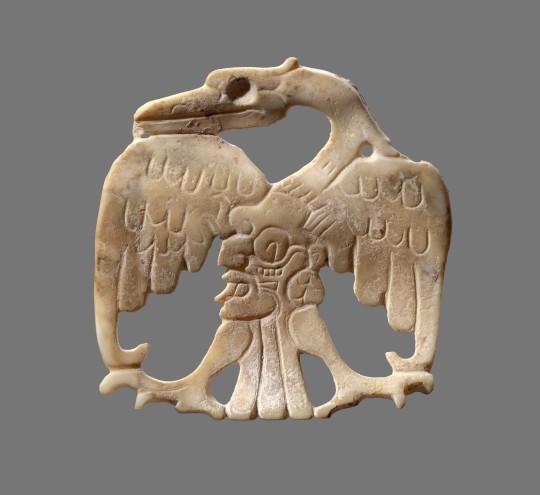
~ Bird ornament.
Date: A.D. 600–800
Place of origin: Guatemala or Mexico, Mesoamerica
Culture: Maya
Medium: Shell
#history#museum#archeology#archaeology#Mesoamerica#precolumbian#bird ornament#guatemala#mexico#7th century#9th century#shell#maya#a.d. 600#a.d. 800
1K notes
·
View notes
Text
The family tree of humanity is much more interconnected than we tend to think. “We’re culturally bound and psychologically conditioned to not think about ancestry in very broad terms,” Rutherford says. Genealogists can only focus on one branch of a family tree at a time, making it easy to forget how many forebears each of us has.
Imagine counting all your ancestors as you trace your family tree back in time. In the nth generation before the present, your family tree has 2n slots: two for parents, four for grandparents, eight for great-grandparents, and so on. The number of slots grows exponentially. By the 33rd generation—about 800 to 1,000 years ago—you have more than eight billion of them. That is more than the number of people alive today, and it is certainly a much larger figure than the world population a millennium ago.
This seeming paradox has a simple resolution: “Branches of your family tree don’t consistently diverge,” Rutherford says. Instead “they begin to loop back into each other.” As a result, many of your ancestors occupy multiple slots in your family tree. For example, “your great-great-great-great-great-grandmother might have also been your great-great-great-great-aunt,” he explains.
The consequence of humanity being “incredibly inbred” is that we are all related much more closely than our intuition suggests, Rutherford says. Take, for instance, the last person from whom everyone on the planet today is descended. In 2004 mathematical modeling and computer simulations by a group of statisticians led by Douglas Rohde, then at the Massachusetts Institute of Technology, indicated that our most recent common ancestor probably lived no earlier than 1400 B.C. and possibly as recently as A.D. 55. In the time of Egypt’s Queen Nefertiti, someone from whom we are all descended was likely alive somewhere in the world.
Go back a bit further, and you reach a date when our family trees share not just one ancestor in common but every ancestor in common. At this date, called the genetic isopoint, the family trees of any two people on the earth now, no matter how distantly related they seem, trace back to the same set of individuals. “If you were alive at the genetic isopoint, then you are the ancestor of either everyone alive today or no one alive today,” Rutherford says. Humans left Africa and began dispersing throughout the world at least 120,000 years ago, but the genetic isopoint occurred much more recently—somewhere between 5300 and 2200 B.C., according to Rohde’s calculations.
At first glance, these dates may seem much too recent to account for long-isolated Indigenous communities in South America and elsewhere. But “genetic information spreads rapidly through generational time,” Rutherford explains. Beginning in 1492, “you begin to see the European genes flowing in every direction until our estimates are that there are no people in South America today who don’t have European ancestry.”
In fact, even more recent than the global genetic isopoint is the one for people with recent European ancestry. Researchers using genomic data place the latter date around A.D. 1000. So Christopher Lee’s royal lineage is unexceptional: because Charlemagne lived before the isopoint and has living descendants, everyone with European ancestry is directly descended from him. In a similar vein, nearly everyone with Jewish ancestry, whether Ashkenazic or Sephardic, has ancestors who were expelled from Spain beginning in 1492. “It’s a very nice example of a small world but looking to the past,” says Susanna Manrubia, a theoretical evolutionary biologist at the Spanish National Center for Biotechnology.
Not everyone of European ancestry carries genes passed down by Charlemagne, however. Nor does every Jew carry genes from their Sephardic ancestors expelled from Spain. People are more closely related genealogically than genetically for a simple mathematical reason: a given gene is passed down to a child by only one parent, not both. In a simple statistical model, Manrubia and her colleagues showed that the average number of generations separating two random present-day individuals from a common genealogical ancestor depends on the logarithm of the relevant population’s size. For large populations, this number is much smaller than the population size itself because the number of possible genealogical connections between individuals doubles with each preceding generation. By contrast, the average number of generations separating two random present-day individuals from a common genetic ancestor is linearly proportional to the population size because each gene can be traced through only one line of a person’s family tree. Although Manrubia’s model unrealistically assumed the population size did not change with time, the results still apply in the real world, she says.
Because of the random reshuffling of genes in each successive generation, some of your ancestors contribute disproportionately to your genome, while others contribute nothing at all. According to calculations by geneticist Graham Coop of the University of California, Davis, you carry genes from fewer than half of your forebears from 11 generations back. Still, all the genes present in today’s human population can be traced to the people alive at the genetic isopoint. “If you are interested in what your ancestors have contributed to the present time, you have to look at the population of all the people that coexist with you,” Manrubia says. “All of them carry the genes of your ancestors because we share the [same] ancestors.”
And because the genetic isopoint occurred so recently, Rutherford says, “in relation to race, it absolutely, categorically demolishes the idea of lineage purity.” No person has forebears from just one ethnic background or region of the world. And your genealogical connections to the entire globe mean that not too long ago your ancestors were involved in every event in world history.
2K notes
·
View notes
Text







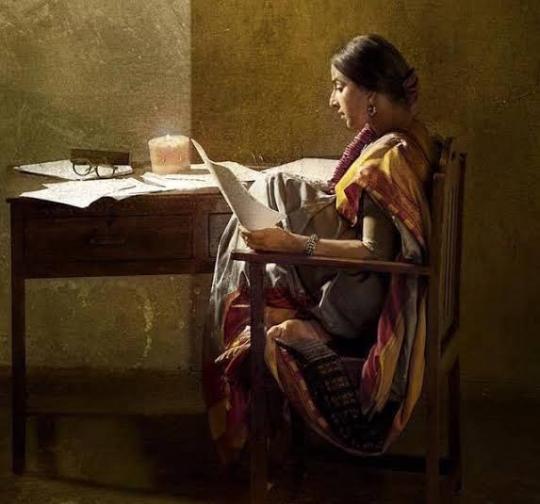
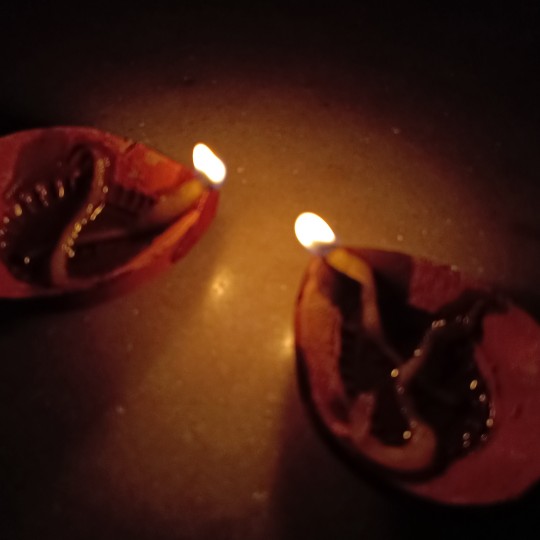
Khona was a poet and astronomer from Deulia village in Bengal, best known for Khonar Bochon, a series of couplets and short rhymes which imparts advice regarding agricultural and rural life. Born somewhere between 800-1200 A.D., Khona defied social and cultural norms of her time when women were rarely taught to read. Her husband Mihir was the son of the philosopher and astronomer Barahmihir, who was one of the navaratnas (nine gems) at the court of Chandragupta II. Khona lived in Chandragupta's court in Pataliputra for a time with her husband and father-in-law. According to legend, Chandragupta was so impressed with Khonar Bochon which benefited the farmers of his state that he named Khona the tenth gem of his court. Khonar Bochon remains relevant to the agricultural life of rural Bengal to the present day.
ষোল চাষে মূলা / তার অর্ধেক তুলা / তার অর্ধেক ধান / বিনা চাষে পান।
Translation: After 16 days of cultivation, radish cultivation in that land gives good yield. Cotton land requires 8 days of cultivation, paddy land after 4 days of cultivation gives good yield. Betel does not require cultivation.
1 / 2 / 3 / 4 / 5 / 6 / 7 / 8 / 9
#mb#khona#khonar bochon#khana#bengali academia#bangla tag#bangladesh#india#desi academia#dark academia#desi aesthetic#desi tag#desi tumblr#desiblr#bengali#indian history#ancient india#khonar bochor for anon#bengali literature
352 notes
·
View notes
Photo




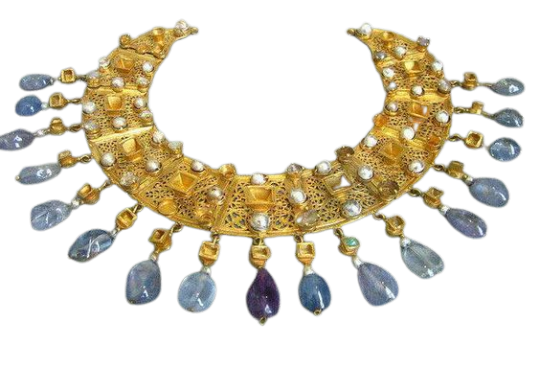




Random PNGs, part 119.
(1. Earrings from Tillya Tepe, 2. Quartz with dumortierite inclusions, 3. Chestnut leaf with golden calligraphy, 4. Egyptian glass Horus head, 5. Byzantine collar with gold & sapphires, 6. World's largest sapphire, 7. A.D. 800–1000 Greek wristbands, 8. Azurite with malachite, 9. Byzantine or Avar gold goblet)
564 notes
·
View notes
Text
It’s never too late for coffee…!!

COFFEE DATES BACK TO 800 A.D…! LEGENDS ARE TOLD THAT GOAT HERDERS SAW THAT THEY’RE GOATS STRTED TO “DANCE” AFTER EATING FRUIT OF THE COFFEA PLANT…! coffee is a fruit cause it has seeds…
61 notes
·
View notes
Text

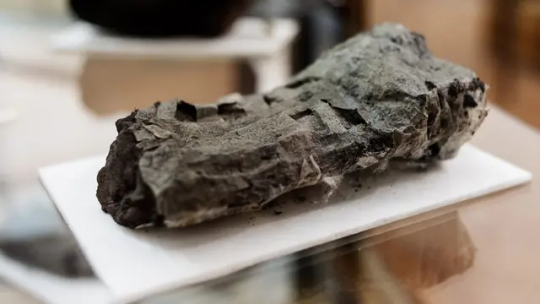
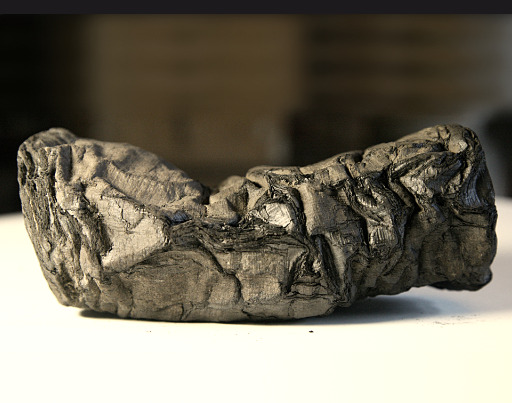
Three Students Just Deciphered the First Passages of a 2,000-Year-Old Scroll Burned in Vesuvius’ Eruption
A Roman scroll, partially preserved when it was buried in the eruption of Mount Vesuvius in A.D. 79, has been virtually unwrapped and decoded using artificial intelligence.
The feat was achieved by three contestants in the Vesuvius Challenge, a competition launched in March 2023 in which people around the world raced to read the ancient Herculaneum papyri.
Papyrologists working with the Vesuvius Challenge believe the scroll contains “never-before-seen text from antiquity,” and the text in question is a piece of Epicurean philosophy on the subject of pleasure. The winning submission shows ancient Greek letters on a large patch of scroll, and the author seems to be discussing the question: are things that are scarce more pleasurable as a result?
The author, whose identity is unconfirmed, doesn’t think so: “As too in the case of food, we do not right away believe things that are scarce to be absolutely more pleasant than those which are abundant,” one passage from the scroll reads.
The three members of the winning team had previously individually made significant contributions to the competition. Luke Farritor, a computer science student at University of Nebraska-Lincoln, and Youssef Nader, a machine learning Ph.D. student at Freie University in Berlin, had been two of the first contestants to detect a smaller number of letters, winning $40,000 and $10,000 respectively. Julian Schilliger, a robotics student at ETH Zürich, developed a tool that began to automatically segment the scrolls. They will share the $700,000 grand prize.
Nat Friedman, a tech investor and executive, and one of the challenge’s organizers, recently printed out the winning submission. “All this has been in this dreamlike digital world in my imagination before," Friedman says. "Seeing it on paper, rolling it up, it just made it so tangible.”
There’s a lot more to discover. The scroll partially decoded by the winning submission was one of 800 discovered in a southern Italian villa that was first uncovered in 1750. The combined efforts of the competitors and organizers so far have resulted in around 5% of one scroll being read.


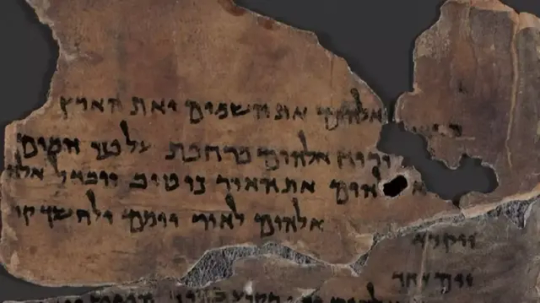

The final scramble to read the scrolls
Since the Vesuvius Challenge launched nearly a year ago, participants had both cooperated and competed, sharing their latest techniques with each other and posting pictures of their progress. But as the race for the grand prize intensified, the Discord, a social media platform where the participants shared information, went dark, says Friedman.
Of the eighteen submissions for the grand prize, most of them were received on the last day of the contest, Dec. 31, and three were sent in the final ten minutes, according to Friedman. Friedman recalls he was at home with his family around Christmas, decorating for the holiday while compulsively refreshing his phone, when the winning submission came in. “I ran into my little office at home and popped it open,” he says. “I was like, ‘Wow, this is really magnificent.’”
In accordance with the criteria set in March 2023, the winning submission contains four passages of 140 characters each, with at least 85% of the characters in each of those passages recoverable by professional papyrologists. It also contains a further 11 columns of text.
It isn’t known who authored the ancient scroll, but experts have developed theories. “Is the author Epicurus' follower, the philosopher and poet Philodemus, the teacher of Vergil? It seems very likely,” writes Richard Janko, professor of classical studies at the University of Michigan. “Is he writing about the effect of music on the hearer, and comparing it to other pleasures like those of food and drink? Quite probably.” Robert Fowler, a professor of Greek at the University of Bristol, also believes the author to be Philodemus. “Like other Epicureans, he valued pleasure above all - but pleasure rightly understood, not mere indulgence,” Fowler writes of the philosopher.
In the final section of the scroll, the author appears to criticize his intellectual adversaries, who “have nothing to say about pleasure, either in general or in particular, when it is a question of definition.”
“I can't help but read it as a 2000 year old blog post, arguing with another poster,” says Friedman. “It's ancient Substack, and people are beefing with each other, and I think that's just amazing.”
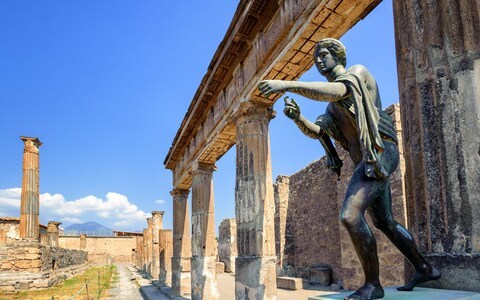
What comes next
The Vesuvius Challenge has issued a new grand prize for 2024 that will allow the AI-enhanced decoding to move at a faster pace.
The competitors largely have been developing algorithms for automatic letter detection—using AI to see traces of ink on segments of virtually unrolled scrolls. Aside from letter detection, the other main challenge associated with reading the scrolls is segmentation—separating the layers and virtually unrolling the scrolls. So far, this process has been highly manual; the Vesuvius Challenge employed three full-time segmenters. In order to ensure that they’d have segmented enough of the scroll for someone to win the grand prize, Friedman bought the team new monitors and computers to boost their productivity. The challenge for 2024 is to automate the segmentation process.
Friedman admits that he has had other tempting offers of new quests to pursue. Over the last year, he says his inbox has been filled with Robinson Crusoe-esque proposals, from people alerting him to lost shipwrecks and ancient cities, undecoded languages, and strange glyphs on the sides of mountains.
But he can’t walk away. He wants to help read all of the 800 scrolls already discovered in the villa. And some archeologists believe there is a main library containing tens of thousands of scrolls, still waiting to be excavated.
To expedite the excavation, Friedman has obtained the mobile number of the Italian civil servant responsible for the villa, whom he has texted, twice. “My hope is that I won't have to go and dig it out myself,” says Friedman. “But if that's what it comes to, I will.”
By WILL HENSHALL.
#AI reads ancient scroll buried by Vesuvius eruption#Three Students Just Deciphered the First Passages of a 2000-Year-Old Scroll Burned in Vesuvius’ Eruption#Herculaneum#Herculaneum papyri#Villa of the Papyri#Mount Vesuvius#ancient artifacts#archeology#archeolgst#history#history news#ancient history#ancient culture#ancient civilizations#roman history#roman empire#long post#long reads
75 notes
·
View notes
Photo
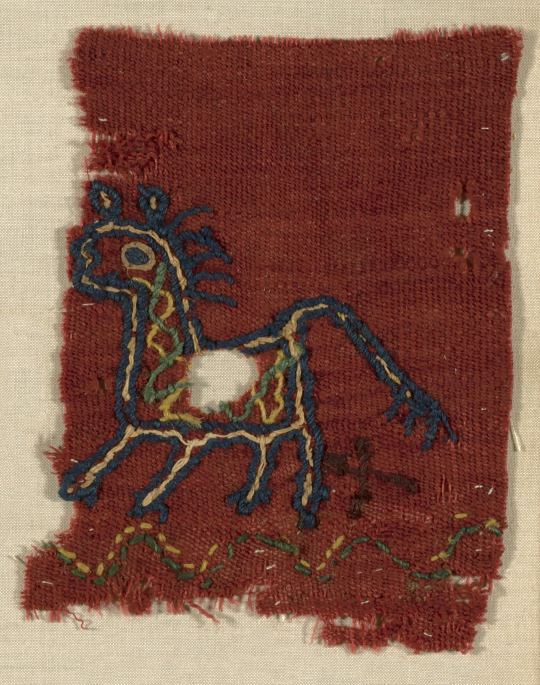
Fragment (made 501 CE–800 CE)
Roman period (30 B.C.– 641 A.D.)/Arab period (641–969), 6th/8th
Coptic
Egypt
Wool, tapestry weave; embroidered
1K notes
·
View notes
Text
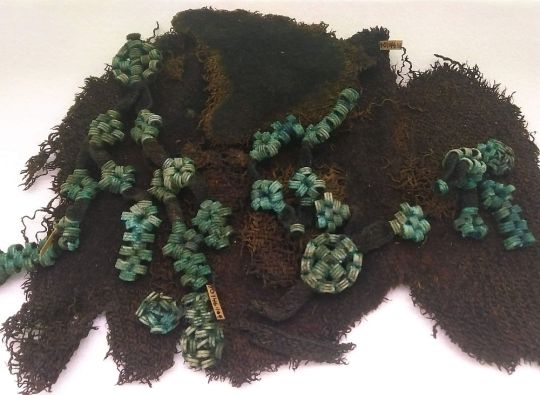


Examples of needle binding / nålbinding dated ca. 500 - 800 A.D. National Museum of Finland.
188 notes
·
View notes
Text


~ Pendant in the Form of a Figure.
Culture: Tiwanaku
Place of origin: Peru
Date: A.D. 400–800
Medium: Shell, stone, silver, copper, and cotton
#ancient#ancient art#history#museum#archeology#archaeology#ancient history#5th century#9th century#pendant in the form of a figure#figure#peru#peruvian#south america#tiwanaku#a.d. 400#a.d. 800
1K notes
·
View notes
Text
Inmate Crucifixion Day!!!
So it's no big surprise that the QSMP has some religious imagery going on, and today's supposed conclusion to the Prison Arc is no exception. Today, the inmates are going to be crucified, and we all know what that is.
Right?
Well, hi, I'm A.D., I'm a historian, and today I'm going to teach you all about crucifixion!
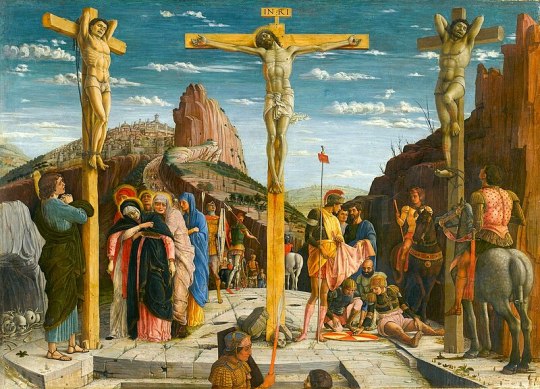
Now, crucifixion is a longstanding execution method that dates back way before Jesus was even thought of. We've got accounts of crucifixions dating back to the Persians under Darius I, and we've got even more accounts from all over the place in the ancient world.
Now, let's go over some history real quick, shall we?
~522 BCE: Polycrates, the tyrant of Samos, is crucified postmortem by some pissed-off Persians. Maybe.
We don't actually know if this one happened or not, but we do know that he was assassinated. That much is true. The crucifixion part is what's up for debate, but, if it is true, then Polycrates here has the privilege of being the first ever victim of crucifixion. Lucky him!
~519 BCE: Darius I orders the crucifixion of something approximating 3,000 political opponents in Babylon
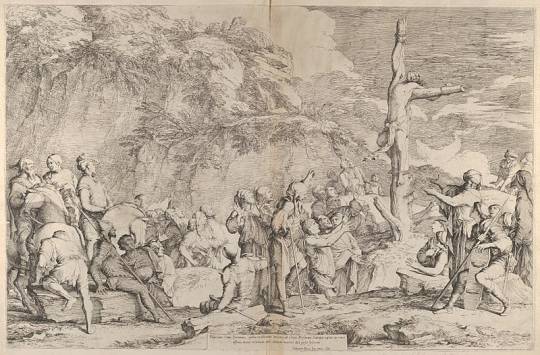
See, the thing about Persian crucifixions is that the prisoners weren't usually nailed to the cross shape we all know. Nah, they were tied up with their hands above their heads, strung up on a single pole. This way, their death would take a lot longer, and the prisoner would suffocate under their own weight. This would last for days, usually with the prisoner being left up to be humiliated even after their death.
~417 BCE: Persian general and tyrant Artaÿctes is crucified by Athenians in a rather uncharacteristic act
But also take this with a grain of salt because this account comes from Herodotus, and I don't trust that dude with much more than a fun story.
The Greeks didn't really think much of crucifixion. They were like, "We're above this. We are civilized", but also. They did not like the whole "Persian Invasion" thing, and so sometimes they ended up resorting to measures they weren't too happy with. Such is war!
~332 BCE: Speaking of war, Alexander the Great supposedly had 2,000 survivors of his siege of Tyre crucified.
The thing with Alexander is that a lot of what people say about him is probably bullshit.
~88 BCE: Ancient Judean king Alexander Jannaeus supposedly had 800 Pharisees-slash-rebels crucified in the middle of Jerusalem
And now we get to the Romans, who kinda perfected the whole thing. They were super into crucifixion. They were so into it that they had a bunch of different ways of doing it!
Getting impaled on a stake
Getting tied to a tree
Getting tied to a crux simplex (see image below)
Getting stuck to a cross

The whole crucifixion thing was seen as a way to deter people from doing the same crimes that the crucified people did. It was all about torture and humiliation. We have reports of people being crucified for days, and of people having to carry their own crucifixes (see: Jesus Christ.)
Sometimes people were tied to their crucifixes. Sometimes they were nailed to them. It varied by region and by criminal and by executor. Criminals were generally stripped completely naked (again, humiliation), though, again, the position depended on the region, criminal, and executor. The way Jewish people were executed was different than how, say, slaves or renegade gladiators were executed.
I'm not going to get into the whole process because that's very long and yucky. But I will repeat just how popular it was! Because MAN, the Romans LOVED it! Crassus ordered the crucifixion of at least 6,000 rebels and followers of Spartacus after the Third Servile War (but, then again, he was a piece of shit.)
Of course, we can't forget about the most famous crucifixion of all:
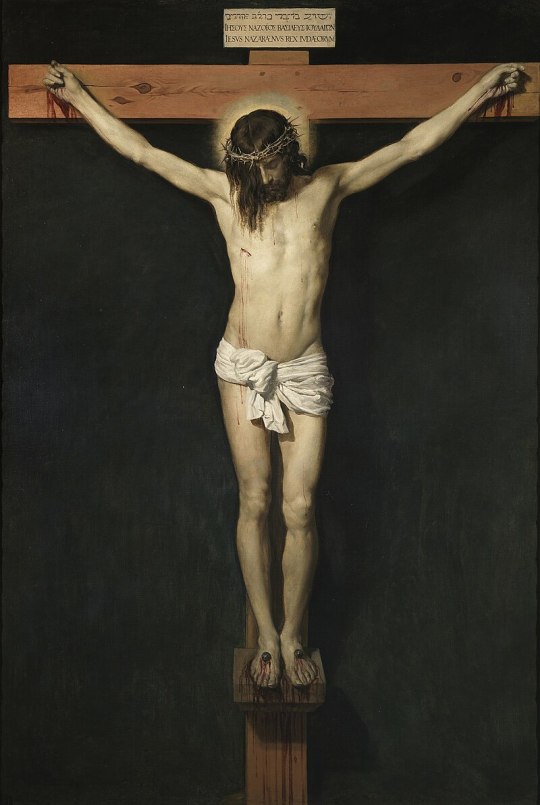
~32 CE: Jesus.
Jesus of Nazareth remains the most famous victim of crucifixion, and it's because of the nature of his particular crucifixion that everybody thinks of crucifixion as The Thing With The Cross.
And this is probably what everybody's thinking of when they're talking about the QSMP inmates being crucified today.
But he wasn't the only religious figure to be crucified!
Cut to:
Either 274 CE or 277 CE: Mani, the Parthian Prophet and the founder of Manichaeism, is crucified in a way super similar to Jesus
Tbh we don't know when he died, but his followers purposefully compared his death to Jesus' despite there possibly being literally no crucifixion involved at all.
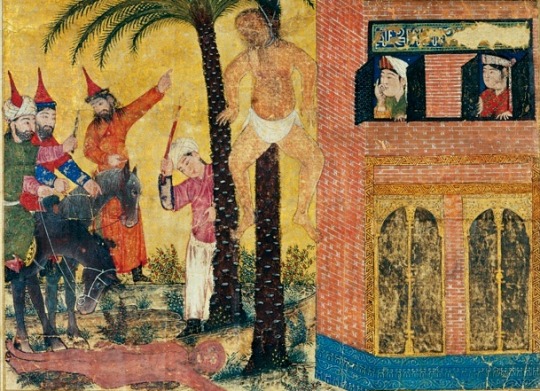
But, you know what? Crucifixion happened all over the place!
Islamic territories had crucifixion going on simply because they lived where crucifixion had been taking place for centuries, and there was a lot of debate surrounding crucifixion in relation to the various rules and regulations surrounding criminality and the potential justification of execution.
Japan, interestingly enough, also has a pretty long history of crucifixion. Supposedly, it was introduced in the 15th century by pesky Christian missionaries, but the Japanese had had a similar tradition going on before that. But Japanese crucifixion, called haritsuke wasn't really like the kind we're familiar with. There was water crucifixion (mizuharitsuke) reserved for Christians, and there was upside-down crucifixion (sakasaharitsuke.) Fun!
(There is photo evidence of this even up on the Wikipedia page, but you can find that on your own. I'm not putting that on my blog, thanks.)
As the years continued, crucifixion became a bit less widespread, though there is photo evidence of its use in Japan up through the 19th century, and then reports of it being used in World War One by the Germans and then in World War Two against the Germans.

Unfortunately, it's still a practiced tradition in a few parts of the world. Saudi Arabia and Sudan still have crucifixion as an execution method, and it's still a reported method being used by certain extremist factions in Syria, Iran and Myanmar.
So... yeah! That's crucifixion for you! It's a truly terrible fate, but not an overtly religious one. It only really became religious when Jesus ended up getting killed, and, even then, it's only seen as such by groups of people steeped in Christian culture (such as many countries and cultures living in what people call "The West".)
I can only imagine that the religious aspect is what's going to come into play on the QSMP, because I doubt that this literal Minecraft Roleplay Series will employ actual literal torture and execution methods live on Twitch.
#a.d. talks history#qsmp#i guess! i talk about it!#anyway all my sources are basically from my head and from some quick research#can you tell i was raised catholic?#and that i took a class on ancient persia last year? lol
46 notes
·
View notes
Text
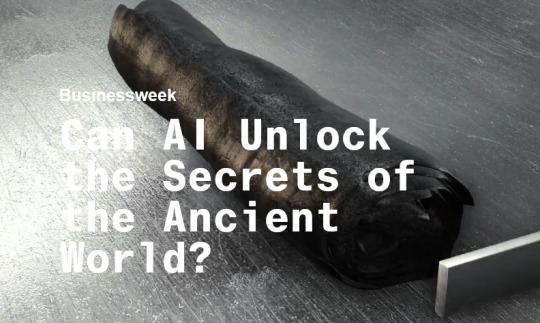
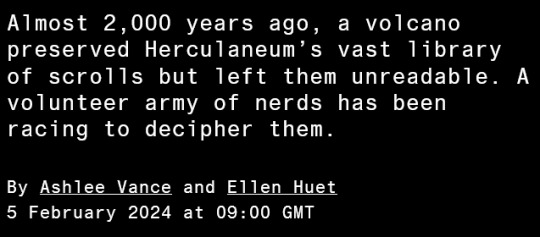
A few years ago, during one of California’s steadily worsening wildfire seasons, Nat Friedman’s family home burned down. A few months after that, Friedman was in Covid-19 lockdown in the Bay Area, both freaked out and bored. Like many a middle-aged dad, he turned for healing and guidance to ancient Rome. While some of us were watching Tiger King and playing with our kids’ Legos, he read books about the empire and helped his daughter make paper models of Roman villas. Instead of sourdough, he learned to bake Panis Quadratus, a Roman loaf pictured in some of the frescoes found in Pompeii. During sleepless pandemic nights, he spent hours trawling the internet for more Rome stuff. That’s how he arrived at the Herculaneum papyri, a fork in the road that led him toward further obsession. He recalls exclaiming: “How the hell has no one ever told me about this?”
The Herculaneum papyri are a collection of scrolls whose status among classicists approaches the mythical. The scrolls were buried inside an Italian countryside villa by the same volcanic eruption in 79 A.D. that froze Pompeii in time. To date, only about 800 have been recovered from the small portion of the villa that’s been excavated. But it’s thought that the villa, which historians believe belonged to Julius Caesar’s prosperous father-in-law, had a huge library that could contain thousands or even tens of thousands more. Such a haul would represent the largest collection of ancient texts ever discovered, and the conventional wisdom among scholars is that it would multiply our supply of ancient Greek and Roman poetry, plays and philosophy by manyfold. High on their wish lists are works by the likes of Aeschylus, Sappho and Sophocles, but some say it’s easy to imagine fresh revelations about the earliest years of Christianity.
“Some of these texts could completely rewrite the history of key periods of the ancient world,” says Robert Fowler, a classicist and the chair of the Herculaneum Society, a charity that tries to raise awareness of the scrolls and the villa site. “This is the society from which the modern Western world is descended.”
The reason we don’t know exactly what’s in the Herculaneum papyri is, y’know, volcano. The scrolls were preserved by the voluminous amount of superhot mud and debris that surrounded them, but the knock-on effects of Mount Vesuvius charred them beyond recognition. The ones that have been excavated look like leftover logs in a doused campfire. People have spent hundreds of years trying to unroll them—sometimes carefully, sometimes not. And the scrolls are brittle. Even the most meticulous attempts at unrolling have tended to end badly, with them crumbling into ashy pieces.
In recent years, efforts have been made to create high-resolution, 3D scans of the scrolls’ interiors, the idea being to unspool them virtually. This work, though, has often been more tantalizing than revelatory. Scholars have been able to glimpse only snippets of the scrolls’ innards and hints of ink on the papyrus. Some experts have sworn they could see letters in the scans, but consensus proved elusive, and scanning the entire cache is logistically difficult and prohibitively expensive for all but the deepest-pocketed patrons. Anything on the order of words or paragraphs has long remained a mystery.
But Friedman wasn’t your average Rome-loving dad. He was the chief executive officer of GitHub Inc., the massive software development platform that Microsoft Corp. acquired in 2018. Within GitHub, Friedman had been developing one of the first coding assistants powered by artificial intelligence, and he’d seen the rising power of AI firsthand. He had a hunch that AI algorithms might be able to find patterns in the scroll images that humans had missed.
After studying the problem for some time and ingratiating himself with the classics community, Friedman, who’s left GitHub to become an AI-focused investor, decided to start a contest. Last year he launched the Vesuvius Challenge, offering $1 million in prizes to people who could develop AI software capable of reading four passages from a single scroll. “Maybe there was obvious stuff no one had tried,” he recalls thinking. “My life has validated this notion again and again.”
As the months ticked by, it became clear that Friedman’s hunch was a good one. Contestants from around the world, many of them twentysomethings with computer science backgrounds, developed new techniques for taking the 3D scans and flattening them into more readable sheets. Some appeared to find letters, then words. They swapped messages about their work and progress on a Discord chat, as the often much older classicists sometimes looked on in hopeful awe and sometimes slagged off the amateur historians.
On Feb. 5, Friedman and his academic partner Brent Seales, a computer science professor and scroll expert, plan to reveal that a group of contestants has delivered transcriptions of many more than four passages from one of the scrolls. While it’s early to draw any sweeping conclusions from this bit of work, Friedman says he’s confident that the same techniques will deliver far more of the scrolls’ contents. “My goal,” he says, “is to unlock all of them.”
Before Mount Vesuvius erupted, the town of Herculaneum sat at the edge of the Gulf of Naples, the sort of getaway wealthy Romans used to relax and think. Unlike Pompeii, which took a direct hit from the Vesuvian lava flow, Herculaneum was buried gradually by waves of ash, pumice and gases. Although the process was anything but gentle, most inhabitants had time to escape, and much of the town was left intact under the hardening igneous rock. Farmers first rediscovered the town in the 18th century, when some well-diggers found marble statues in the ground. In 1750 one of them collided with the marble floor of the villa thought to belong to Caesar’s father-in-law, Senator Lucius Calpurnius Piso Caesoninus, known to historians today as Piso.
During this time, the first excavators who dug tunnels into the villa to map it were mostly after more obviously valuable artifacts, like the statues, paintings and recognizable household objects. Initially, people who ran across the scrolls, some of which were scattered across the colorful floor mosaics, thought they were just logs and threw them on a fire. Eventually, though, somebody noticed the logs were often found in what appeared to be libraries or reading rooms, and realized they were burnt papyrus. Anyone who tried to open one, however, found it crumbling in their hands.
Terrible things happened to the scrolls in the many decades that followed. The scientif-ish attempts to loosen the pages included pouring mercury on them (don’t do that) and wafting a combination of gases over them (ditto). Some of the scrolls have been sliced in half, scooped out and generally abused in ways that still make historians weep. The person who came the closest in this period was Antonio Piaggio, a priest. In the late 1700s he built a wooden rack that pulled silken threads attached to the edge of the scrolls and could be adjusted with a simple mechanism to unfurl the document ever so gently, at a rate of 1 inch per day. Improbably, it sort of worked; the contraption opened some scrolls, though it tended to damage them or outright tear them into pieces. In later centuries, teams organized by other European powers, including one assembled by Napoleon, pieced together torn bits of mostly illegible text here and there.
Today the villa remains mostly buried, unexcavated and off-limits even to the experts. Most of what’s been found there and proven legible has been attributed to Philodemus, an Epicurean philosopher and poet, leading historians to hope there’s a much bigger main library buried elsewhere on-site. A wealthy, educated man like Piso would have had the classics of the day along with more modern works of history, law and philosophy, the thinking goes. “I do believe there’s a much bigger library there,” says Richard Janko, a University of Michigan classical studies professor who’s spent painstaking hours assembling scroll fragments by hand, like a jigsaw puzzle. “I see no reason to think it should not still be there and preserved in the same way.” Even an ordinary citizen from that time could have collections of tens of thousands of scrolls, Janko says. Piso is known to have corresponded often with the Roman statesman Cicero, and the apostle Paul had passed through the region a couple of decades before Vesuvius erupted. There could be writings tied to his visit that comment on Jesus and Christianity. “We have about 800 scrolls from the villa today,” Janko says. “There could be thousands or tens of thousands more.”
In the modern era, the great pioneer of the scrolls is Brent Seales, a computer science professor at the University of Kentucky. For the past 20 years he’s used advanced medical imaging technology designed for CT scans and ultrasounds to analyze unreadable old texts. For most of that time he’s made the Herculaneum papyri his primary quest. “I had to,” he says. “No one else was working on it, and no one really thought it was even possible.”
Progress was slow. Seales built software that could theoretically take the scans of a coiled scroll and unroll it virtually, but it wasn’t prepared to handle a real Herculaneum scroll when he put it to the test in 2009. “The complexity of what we saw broke all of my software,” he says. “The layers inside the scroll were not uniform. They were all tangled and mashed together, and my software could not follow them reliably.”
By 2016 he and his students had managed to read the Ein Gedi scroll, a charred ancient Hebrew text, by programming their specialized software to detect changes in density between the burnt manuscript and the burnt ink layered onto it. The software made the letters light up against a darker background. Seales’ team had high hopes to apply this technique to the Herculaneum papyri, but those were written with a different, carbon-based ink that their imaging gear couldn’t illuminate in the same way.
Over the past few years, Seales has begun experimenting with AI. He and his team have scanned the scrolls with more powerful imaging machines, examined portions of the papyrus where ink was visible and trained algorithms on what those patterns looked like. The hope was that the AI would start picking up on details that the human eye missed and could apply what it learned to more obfuscated scroll chunks. This approach proved fruitful, though it remained a battle of inches. Seales’ technology uncovered bits and pieces of the scrolls, but they were mostly unreadable. He needed another breakthrough.
Friedman set up Google alerts for Seales and the papyri in 2020, while still early in his Rome obsession. After a year passed with no news, he started watching YouTube videos of Seales discussing the underlying challenges. Among other things, he needed money. By 2022, Friedman was convinced he could help. He invited Seales out to California for an event where Silicon Valley types get together and share big ideas. Seales gave a short presentation on the scrolls to the group, but no one bit. “I felt very, very guilty about this and embarrassed because he’d come out to California, and California had failed him,” Friedman says.
On a whim, Friedman proposed the idea of a contest to Seales. He said he’d put up some of his own money to fund it, and his investing partner Daniel Gross offered to match it.
Seales says he was mindful of the trade-offs. The Herculaneum papyri had turned into his life’s work, and he wanted to be the one to decode them. More than a few of his students had also poured time and energy into the project and planned to publish papers about their efforts. Now, suddenly, a couple of rich guys from Silicon Valley were barging into their territory and suggesting that internet randos could deliver the breakthroughs that had eluded the experts.
More than glory, though, Seales really just hoped the scrolls would be read, and he agreed to hear Friedman out and help design the AI contest. They kicked off the Vesuvius Challenge last year on the Ides of March. Friedman announced the contest on the platform we fondly remember as Twitter, and many of his tech friends agreed to pledge their money toward the effort while a cohort of budding papyrologists began to dig into the task at hand. After a couple of days, Friedman had amassed enough money to offer $1 million in prizes, along with some extra money to throw at some of the more time-intensive basics.
Friedman hired people online to gather the existing scroll imagery, catalog it and create software tools that made it easier to chop the scrolls into segments and to flatten the images out into something that was readable on a computer screen. After finding a handful of people who were particularly good at this, he made them full members of his scroll contest team, paying them $40 an hour. His hobby was turning into a lifestyle.
The initial splash of attention helped open new doors. Seales had lobbied Italian and British collectors for years to scan his first scrolls. Suddenly the Italians were now offering up two new scrolls for scanning to provide more AI training data. With Friedman’s backing, a team set to work building precision-fitting, 3D-printed cases to protect the new scrolls on their private jet flight from Italy to a particle accelerator in England. There they were scanned for three days straight at a cost of about $70,000.
Seeing the imaging process in action drives home both the magic and difficulty inherent in this quest. One of the scroll remnants placed in the scanner, for example, wasn’t much bigger than a fat finger. It was peppered by high-energy X-rays, much like a human going through a CT scan, except the resulting images were delivered in extremely high resolution. (For the real nerds: about 8 micrometers.) These images were virtually carved into a mass of tiny slices too numerous for a person to count. Along each slice, the scanner picked up infinitesimal changes in density and thickness. Software was then used to unroll and flatten out the slices, and the resulting images looked recognizably like sheets of papyrus, the writing on them hidden.
The files generated by this process are so large and difficult to deal with on a regular computer that Friedman couldn’t throw a whole scroll at most would-be contest winners. To be eligible for the $700,000 grand prize, contestants would have until the end of 2023 to read just four passages of at least 140 characters of contiguous text. Along the way, smaller prizes ranging from $1,000 to $100,000 would be awarded for various milestones, such as the first to read letters in a scroll or to build software tools capable of smoothing the image processing. With a nod to his open-source roots, Friedman insisted these prizes could be won only if the contestants agreed to show the world how they did it.
Luke Farritor was hooked from the start. Farritor—a bouncy 22-year-old Nebraskan undergraduate who often exclaims, “Oh, my goodness!”—heard Friedman describe the contest on a podcast in March. “I think there’s a 50% chance that someone will encounter this opportunity, get the data and get nerd-sniped by it, and we’ll solve it this year,” Friedman said on the show. Farritor thought, “That could be me.”
The early months were a slog of splotchy images. Then Casey Handmer, an Australian mathematician, physicist and polymath, scored a point for humankind by beating the computers to the first major breakthrough. Handmer took a few stabs at writing scroll-reading code, but he soon concluded he might have better luck if he just stared at the images for a really long time. Eventually he began to notice what he and the other contestants have come to call “crackle,” a faint pattern of cracks and lines on the page that resembles what you might see in the mud of a dried-out lakebed. To Handmer’s eyes, the crackle seemed to have the shape of Greek letters and the blobs and strokes that accompany handwritten ink. He says he believes it to be dried-out ink that’s lifted up from the surface of the page.
The crackle discovery led Handmer to try identifying clips of letters in one scroll image. In the spirit of the contest, he posted his findings to the Vesuvius Challenge’s Discord channel in June. At the time, Farritor was a summer intern at SpaceX. He was in the break room sipping a Diet Coke when he saw the post, and his initial disbelief didn’t last long. Over the next month he began hunting for crackle in the other image files: one letter here, another couple there. Most of the letters were invisible to the human eye, but 1% or 2% had the crackle. Armed with those few letters, he trained a model to recognize hidden ink, revealing a few more letters. Then Farritor added those letters to the model’s training data and ran it again and again and again. The model starts with something only a human can see—the crackle pattern—then learns to see ink we can’t.
Unlike today’s large-language AI models, which gobble up data, Farritor’s model was able to get by with crumbs. For each 64-pixel-by-64-pixel square of the image, it was merely asking, is there ink here or not? And it helped that the output was known: Greek letters, squared along the right angles of the cross-hatched papyrus fibers.
In early August, Farritor received an opportunity to put his software to the test. He’d returned to Nebraska to finish out the summer and found himself at a house party with friends when a new, crackle-rich image popped up in the contest’s Discord channel. As the people around him danced and drank, Farritor hopped on his phone, connected remotely to his dorm computer, threw the image into his machine-learning system, then put his phone away. “An hour later, I drive all my drunk friends home, and then I’m walking out of the parking garage, and I take my phone out not expecting to see anything,” he says. “But when I open it up, there’s three Greek letters on the screen.”
Around 2 a.m., Farritor texted his mom and then Friedman and the other contestants about what he’d found, fighting back tears of joy. “That was the moment where I was like, ‘Oh, my goodness, this is actually going to work. We’re going to read the scrolls.’”
Soon enough, Farritor found 10 letters and won $40,000 for one of the contest’s progress prizes. The classicists reviewed his work and said he’d found the Greek word for “purple.”
Farritor continued to train his machine-learning model on crackle data and to post his progress on Discord and Twitter. The discoveries he and Handmer made also set off a new wave of enthusiasm among contestants, and some began to employ similar techniques. In the latter part of 2023, Farritor formed an alliance with two other contestants, Youssef Nader and Julian Schilliger, in which they agreed to combine their technology and share any prize money.
In the end, the Vesuvius Challenge received 18 entries for its grand prize. Some submissions were ho-hum, but a handful showed that Friedman’s gamble had paid off. The scroll images that were once ambiguous blobs now had entire paragraphs of letters lighting up across them. The AI systems had brought the past to life. “It’s a situation that you practically never encounter as a classicist,” says Tobias Reinhardt, a professor of ancient philosophy and Latin literature at the University of Oxford. “You mostly look at texts that have been looked at by someone before. The idea that you are reading a text that was last unrolled on someone’s desk 1,900 years ago is unbelievable.”
A group of classicists reviewed all the entries and did, in fact, deem Farritor’s team the winners. They were able to stitch together more than a dozen columns of text with entire paragraphs all over their entry. Still translating, the scholars believe the text to be another work by Philodemus, one centered on the pleasures of music and food and their effects on the senses. “Peering at and beginning to transcribe the first reasonably legible scans of this brand-new ancient book was an extraordinarily emotional experience,” says Janko, one of the reviewers. While these passages aren’t particularly revelatory about ancient Rome, most classics scholars have their hopes for what might be next.
There’s a chance that the villa is tapped out—that there are no more libraries of thousands of scrolls waiting to be discovered—or that the rest have nothing mind-blowing to offer. Then again, there’s the chance they contain valuable lessons for the modern world.
That world, of course, includes Ercolano, the modern town of about 50,000 built on top of ancient Herculaneum. More than a few residents own property and buildings atop the villa site. “They would have to kick people out of Ercolano and destroy everything to uncover the ancient city,” says Federica Nicolardi, a papyrologist at the University of Naples Federico II.
Barring a mass relocation, Friedman is working to refine what he’s got. There’s plenty left to do; the first contest yielded about 5% of one scroll. A new set of contestants, he says, might be able to reach 85%. He also wants to fund the creation of more automated systems that can speed the processes of scanning and digital smoothing. He’s now one of the few living souls who’s roamed the villa tunnels, and he says he’s also contemplating buying scanners that can be placed right at the villa and used in parallel to scan tons of scrolls per day. “Even if there’s just one dialogue of Aristotle or a beautiful lost Homeric poem or a dispatch from a Roman general about this Jesus Christ guy who’s roaming around,” he says, “all you need is one of those for the whole thing to be more than worth it.”
26 notes
·
View notes
Text
Russian forces reportedly stole priceless Scythian treasures from Ukrainian museum

Russian soldiers have reportedly stolen gold Scythian artifacts dating back about 2,300 years from the Melitopol Museum of Local History in Ukraine. Additionally, there are reports that a museum staff member is currently being held by the Russian military.
The Scythians, culturally related groups of nomadic pastoralists and formidable warriors, thrived across Eurasia between roughly 800 B.C. and A.D. 300 and crafted many beautiful artifacts out of gold.
Melitopol, located in southeastern Ukraine, has been occupied by the Russian military since March 1, according to news reports. Since the Russians started their invasion of Ukraine on Feb. 24, they have captured large swaths of territory in the eastern and southern parts of the country. However, their attempts to take the capital city of Kyiv have failed. Read more.
959 notes
·
View notes
Text
Aziraphale and Crowley Timeline
I made a timeline of the Aziraphale and Crowley relationship based on the TV show, book, stage directions, and Neil Gaiman’s blog. It was designed to track negative space and off-screen interactions for the purposes of fic writing, so maybe other fic writers would enjoy it. Please add anything I missed. I’ll edit as necessary.
Before the Beginning — Nebula rollout
Aziraphale shares his name with a heavy implication that they have not met before.
Crowley tells Nina and Maggie, “We’ve been talking for millions of years,” implying some sort of relationship before Crowley’s fall.
Sunday, October 21, 4004 B.C. at 9:13 a.m. — The creation of the universe
4004 B.C., "just after the beginning" — The Garden of Eden
Crowley (Crawly) tells Aziraphale his new name, which implies minimal interaction since Crowley’s fall. They were aware of each other’s presence in the garden as evidenced by Crowley having noticed the flaming sword.
3004 B.C., Mesopotamia — Noah’s Ark
Crowley follows up on the flaming sword, which implies but does not confirm that they haven’t interacted since Eden.
[3004 BC - 2500 BC: NO INTERACTION as evidenced by Aziraphale’s comment, “I haven’t seen you since the flood.”
2500 B.C., Land of Uz — Job
2000 B.C., Sodom and Gomorrah
It’s confirmed from the TV show that Aziraphale was present (as evidenced by their comment about Sandalphon’s participation)
It’s confirmed from the book that Crowley was not present and did not visit afterwards.
[800 BC - 200 BC: Deleted scene from TV show, Arabian Nights-inspired]
33 A.D., Golgotha — The crucifixion
41 A.D., Rome — Aziraphale runs into Crowley
537 A.D., Kingdom of West Essex — Crowley suggests they stop working just to cancel each other out
[1020 A.D. (BOOK CANON) — Arrangement (non-interference) is established. Then, they extend the arrangement to “hold the fort” for one another.]
[1023 A.D. (BOOK CANON) — Crowley comes back to argue that you need to start people off equal in order to let them choose between good and evil, equivalent of The Resurrectionists in the TV series.]
[1400s: “Papal” scene, cut from TV show]
[1567 A.D. — Mary Queen of Scots dies, this scene was cut and converted to The Resurrectionists]
[1556 AD - 1598 AD (BOOK CANON): Crowley is in Spain when he receives a commendation for the Spanish Inquisition. He checks it out then comes back and gets drunk for a week. Time range is evidenced by the line, “That Hieronymus Bosch,” who is a painter who inspired King Phillip II.]
1601, Globe Theatre, London — Hamlet
CONFIRMED: Multiple interactions between Wessex (537 AD) and now as evidenced by Crowley’s statement that they’ve covered for each other “dozens of times now.”
1650, Unknown — First “I Was Wrong” dance (performed by Aziraphale)
[1600 - 1800, United States: A scene set during the Wild West, cut from TV show]
1793, Paris — The French Revolution
A recent interaction is implied by Crowley saying, “I thought you were opening a bookshop.”
1800, London — The bookshop opens (confirmed that it opened “a couple years” after Mr. Hatchard in Piccadilly, founded 1797)
[Book — Crowley is asleep through most of the 19th century, gets up in 1832 for bathroom]
1820s, U.K. — Aziraphale’s diary excerpt, in which he mentions that he told Crowley the story “afterwards” (although “afterwards” can be a very long time for two immortal beings so it doesn’t confirm much)
1827, Edinburgh — The Resurrectionists
[Confirmed: “It was the last I was to see of Crowley for quite some time.”]
1862, St. James Park, London — Crowley requests holy water
Their understanding of the agreement is, “Stay out of each other’s way. Lend a hand when needed.”
[1862 - 1941: NO INTERACTION as evidenced by the stage directions that Aziraphale has not seen Crowley in a hundred years.]
1941, London
[1960s: cut scene set in America, note: both female-presenting]
1967, Soho — Aziraphale gets holy water for Crowley
2008, U.K. — Antichrist is born
2013, U.S. — Crowley and Aziraphale both begin work for the Dowlings
[“The story starts, as it will end, in a garden” — although technically garden is no longer where it started]
#good omens#aziraphale#crowley#neil gaiman#good omens timeline#aziracrow#good omens fandom#good omens fanfiction
44 notes
·
View notes
Photo

Vessel with Feline Mother Nursing Cubs
Andes, Chancay, A.D. 800–1300
Ceramic with pigment
Yale Peabody Museum of Natural History
Anni and Josef Albers Collection
48 notes
·
View notes
Text

Model Depicting a Ritual Center
Nayarit
100–800 CE
In West Mexico, chiefdoms and statelike societies flourished between A.D. 100 and 800. Advanced agriculture, extensive trade routes, and elaborate religious festivals echoed developments in other regions of ancient Mesoamerica. The distinctive West Mexican sculptures were often included as offerings in tombs that illustrate important themes of life and the afterlife. This model of a circular ceremonial center depicts houselike temples, populated by flute players, a drummer, conch-shell trumpeters, dancers, women with children, and animals. A masked figure—likely the ruler—stands atop the central stepped pyramid.
source
15 notes
·
View notes
Photo
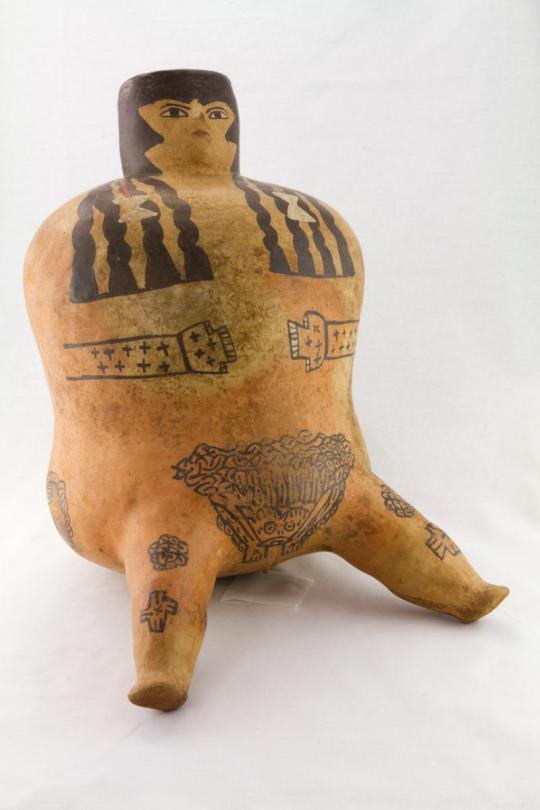
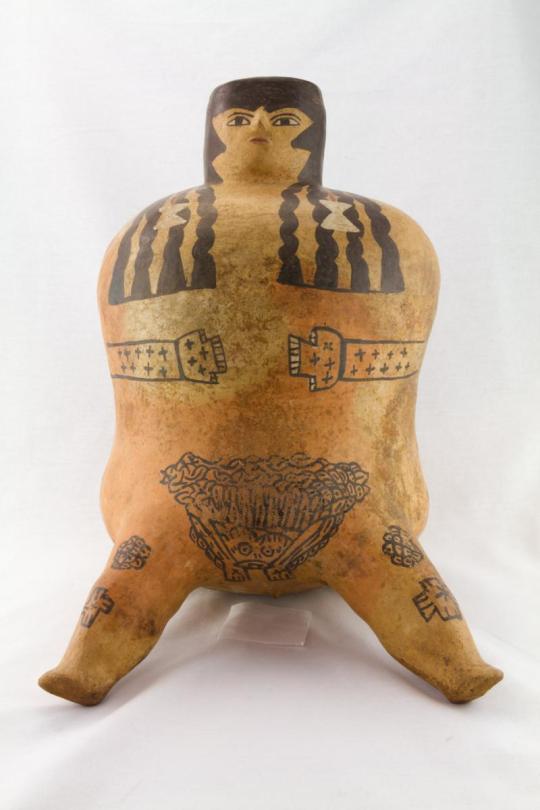

Ceramic Nasca Vessel. Nasca, Perú, south coast, 100 B.C. – A.D. 800.
262 notes
·
View notes